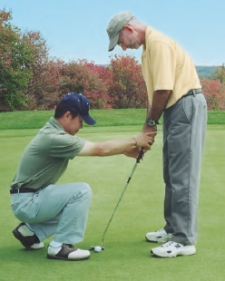Taking Your Student’s Poor Performance Home with You
 We have all experienced it at one time or another, perhaps more than we care to think about: A student is completely unable to grasp our teaching. Despite our best efforts, he or she is showing no improvement under out tutelage.
We have all experienced it at one time or another, perhaps more than we care to think about: A student is completely unable to grasp our teaching. Despite our best efforts, he or she is showing no improvement under out tutelage.
To a conscientious teacher, this is very troubling. Teachers who care tend to take their students’ poor performances home with them. It can lead to all sorts of soul-searching, ranging from individual questions about how to better approach that particular student to even wondering if we are really competent as a teacher in the first place!
If you’ve watched various iterations of The Haney Project on Golf Channel, where he teaches celebrity amateur golfers, you have undoubtedly heard Hank Haney pass the student’s failures and setbacks off onto the student – in other words, it wasn’t Haney’s fault. This in no way implies Haney doesn’t care; rather, it shows that he has learned that a teacher can’t always be responsible for students who don’t “get it.”
It’s hard to come to this realization sometimes – that our student is not improving because of their ineptness, for lack of a better word – because caring teachers are always looking for ways that they can change their instruction to better resonate with the student. Sometimes we must come to the realization that the student’s habits are simply too ingrained for them to change, or that they may have some mental block prohibiting change.
A case in point concerns one of our USGTF examiners who had a student named Frank. Frank was a 12-handicapper who wanted to get better. He had a severe lower body sway and a reverse spine tilt at the top of his backswing. The examiner tried everything he could think of to get Frank into a better position at the top, but nothing worked. He even consulted with other examiners to see if they had some ideas, and a couple were incorporated into Frank’s lessons. Still, nothing worked. The examiner was bothered by his student’s lack of improvement, But the bottom line was that Frank was the reason Frank did not improve.
This seems to contradict what is written on page 13 of The American Golf Teaching Method manual: “If someone isn’t learning, someone isn’t teaching.” However, in this case, Frank learned plenty; he just wasn’t willing to accept it, for whatever reason. Sometimes we must accept the fact that a particular student is just not teachable or coachable.
There are also times when we must recognize that we are not a good fit for a particular student. Maybe we are more analytical in our teaching when a student is more feel-oriented, or vice versa. Maybe our personality is more jovial while a student is more businesslike, or vice versa. This is certainly no slight on us. We are all different with different strengths and weaknesses. Even highly-paid tour gurus at the top of their profession have amateur students with whom they are not a good fit.
Nevertheless, we must always ask ourselves if we could have done more for a particular student. If the answer is genuinely “no,” then we can be Satisfied we have done our best, and we should not lose sleep over it.




